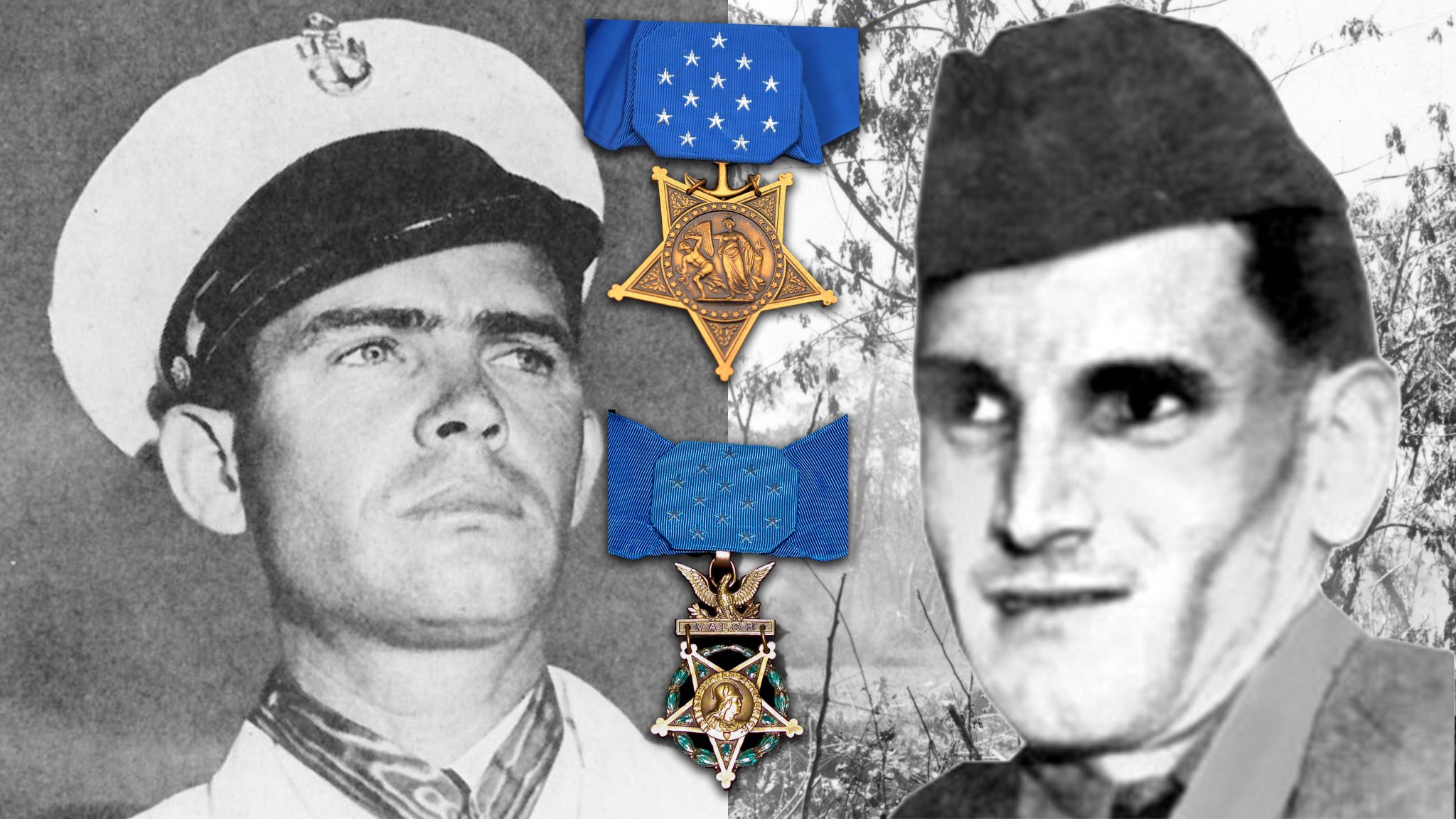

Close to 15 million Americans served in the military during World War II. But the Medal of Honor, the nation’s highest award for combat bravery, was awarded just 473 times.
The first was awarded to a Navy sailor in Hawaii who fired at Japanese bombers before the first bombs fell on Pearl Harbor. The last went to an Army soldier for fighting in the jungle-covered mountains of Luzon in the Phillippines, less than two weeks before the atomic bomb fell on Hiroshima.
These are the stories of the first and last Medals of Honor in World War II
The first bombs of the war
Navy Aviation Chief Ordnanceman John Finn was the first to earn the Medal of Honor on Dec. 7, 1941, fighting Japanese bombers that were part of the attack on Pearl Harbor.
Finn jumped into action as bombers attacked Naval Air Station, Kaneohe Bay, a naval base hit by the Japanese eight minutes before the first bombs landed on Pearl Harbor. Finn manned a .50-caliber machine gun in a completely exposed position on a parking ramp, exchanging fire with the diving Japanese planes. He was wounded multiple times but fought through the pain to repel the sudden ambush on the base.
“It was only by specific orders that he was persuaded to leave his post to seek medical attention,” reads Finn’s Medal of Honor citation. “Following first-aid treatment, although obviously suffering much pain and moving with great difficulty, he returned to the squadron area and actively supervised the rearming of returning planes.”
By the end of the day, Finn would be one of 16 U.S. servicemembers whose actions during Japanese attacks would be awarded Medals of Honor. Besides Finn, 14 went to sailors and soldiers at Pearl Harbor. The last went to Marine 1st Lt. George Ham Cannon on Sand Island at Midway when the small U.S. airfield there was shelled by the Japanese Navy. Cannon was in a reinforced communications bunker on the island when a shell skipped off a nearby building and crashed through an air vent on the bunker, exploding. Despite grave injuries, Cannon oversaw the reestablishment of communications for the island and oversaw the evacuation of his men before dying of his wounds.
Cannon was the first Marine of the war to receive the Medal of Honor.
The last Medal of Honor in Europe
The attacks on Pearl Harbor pulled the U.S. into war in both the Pacific and Europe, theaters that operated mostly as independent wars.
Victory in Europe Day (V-E Day) came after Germany surrendered on May 8, 1945. The last action for which a Medal of Honor was awarded came two months before V-E Day during a glider assault on Wesel, Germany, on March 27, 1945.
Technical Sergeant Clinton Hedrick was assigned to Company I, 194th Glider Infantry, 17th Airborne Division. Hedrick and fellow paratroopers were the leading assault platoon for taking Lembeck, Germany. They were pinned down by heavily armed and entrenched German fire three different times during the initial assault. Each time, Hedrick charged through heavy fire, firing his automatic rifle from the hip. During an attempted flanking maneuver, Hedrick turned towards six German soldiers and opened fire, dropping all of them.
He then pursued the retreating Germans across a river into Lembeck Castle. When a German soldier approached Hedrick with his hands up, declaring the Nazi garrison was surrendering, Hedrick entered the castle yard with four of his squad mates to accept their surrender.
“The group moved through a sally port and was met by fire from a German self-propelled gun,” reads Hedrick’s Medal of Honor citation. “Although mortally wounded, Hedrick fired at the enemy gun and covered the withdrawal of his comrades. He died while being evacuated after the castle was taken.”
Final Medal of Honor of World War II
World War II came to a formal end on Sept. 2, 1945, when Japanese officials signed formal surrender documents aboard the USS Missouri, but fighting effectively ended on Aug. 15, days after the second atomic bomb was dropped on Nagasaki.
But combat raged nearly until the final days on Okinawa and in the Phillippines, including the actions of Army Cpl. Melvin Mayfield July 29, 1945, during the Battle of Luzon.
Luzon was one of the longest battles of the war, beginning on Jan. 9, 1945.
By July, Mayfield was in the fighting as an infantryman assigned to Company D, 1st Battalion, 20th Infantry, 6th Infantry Division. Company D was sent to aid two Filipino companies pinned down by enemy forces on a circular ridge in the Cordillera Mountains.
Mayfield moved from shell hole to shell hole until he reached a series of four caves at the top of the hill from which the enemy was raining down fire.
“With grenades and his carbine, he assaulted each of the caves while enemy fire pounded about him. However, before he annihilated the last hostile redoubt, a machine-gun bullet destroyed his weapon and slashed his left hand,” reads Mayfield’s Medal of Honor citation. “Disregarding his wound, he secured more grenades and dauntlessly charged again into the face of point-blank fire to help destroy a hostile observation post.”
After the war
Finn became an officer and left the military with the rank of lieutenant, retiring from the Navy in 1956. At the age of 100, he passed away on May 27, 2010, in Chula Vista, California. Mayfield died at 71 on June 19, 1990.
The latest on Task & Purpose
- Marine Corps commandant completes combat fitness test 11 months after open heart surgery
- How generals and admirals get promoted now and how that may change under Trump
- 101st Airborne soldier ‘ain’t come to play’ in cage match video
- Army puts up $15,000 reward to help find 31 pistols and optics stolen from Fort Moore
- ‘Andor’ shows even the Empire has the Pentagon’s acquisition model
